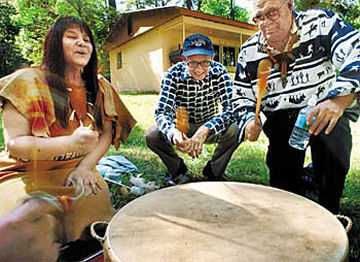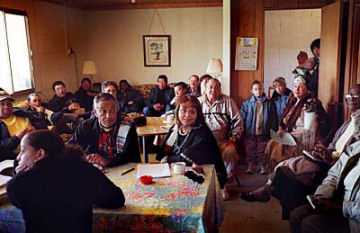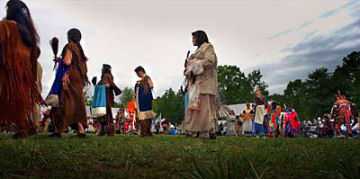By Diane Tennant, The Virginian-Pilot © May 27, 2002

Part 2 of 2
An eagle feather comes in three colors. Its vanes branch in different directions, yet meet in the middle. Symbolic, it is said, of the Nottoway/Cheroenhaka Indians. The Cheroenhaka, long ago, split apart. Some went away with their Iroquois cousins, the Tuscarora, north to a sanctuary far from the encroaching English, north to Canada. Others stayed home, lying low and adopting the names and races of foreigners with more status than their own. They stayed south in the land of their ancestors, Southampton County. Centuries passed, memories faded, blood diluted.
An eagle feather comes in three colors. Its vanes branch in different directions, yet meet in the middle.
Symbolic, it is said, of the Nottoway/Cheroenhaka Indians.
The Cheroenhaka, long ago, split apart. Some went away with their Iroquois cousins, the Tuscarora, north to a sanctuary far from the encroaching English, north to Canada.
Others stayed home, lying low and adopting the names and races of foreigners with more status than their own. They stayed south in the land of their ancestors, Southampton County.
Centuries passed, memories faded, blood diluted.
The northern branch retained the name Nottoway: “Snake” or “enemy” as christened by the Algonquins around Jamestown.
The southern branch has reorganized as the Cheroenhaka: “People at the Fork of the Stream,” in Iroquois.
Now they meet.
Julianne Jennings began looking for her Nottoway roots last summer. The Rhode Island woman, who had always known more about her Pequot ancestry, came to Virginia in search of Jennings Ordinary. The small community in Nottoway County descended from a home established by an English settler on lands granted by the king, regardless of Indian rights.
“Mr. Jennings had five children with a Nottoway Indian woman and sent them up north,” Jennings said. “I was a product of what Jennings probably didn’t want to talk about.”
She went from Nottoway County to Richmond to Southampton County, where the librarian introduced her to Francis Kello, whose family now owns part of the old Nottoway reservation. He took her to see it, and they found pottery fragments in the plowed field where the Indian village stood in 1728. Jennings felt like she was home.
“It has been such an incredible awakening,” she said. “I don’t know why this is happening, but it’s happening.”
Partly because of her search, the descendants of the Nottoway/Cheroenhaka met for the first time on Feb. 2, in Kello’s river cottage. Meherrin Indians were there, to give guidance. Weanocks were there, for kinship. Tuscarora were there, representing the Nottoway Confederation, organized in 1997 to bring together Iroquois groups.
Also there was Helen Rountree, an anthropologist retired from Old Dominion University who wrote a 1987 journal article titled “The Termination and Dispersal of the Nottoway Indians of Virginia.” She defined termination as the cessation of government protection and services, the liquidation of the tribe as a legal entity and the division of tribal property among the members, who were then no longer considered Indians for legal purposes.
The Nottoway Confederation took umbrage at that term. “We basically found, in legal language, that the Nottoway people were never really terminated,” said Dr. Robert M. Chavis, a family practitioner and Tuscarora clan chief in Maxton, N.C. “Allotments were given out, but the tribe never came together as a whole and said we will no longer be a tribe.”
The confederation is seeking a clarification of the tribe’s status from Virginia’s attorney general. A ruling in its favor would save paperwork and legal fees, Chavis said.
Rountree, who took minutes for the tribe’s Feb. 2 meeting, wrote that her article was the only document to ever call the Nottoway terminated. “They are, however, `extinct’ AS A TRIBE in the eyes of the Virginia government,” she wrote.
Chavis, whose great-grandfather was born in Southampton County, said Indians have been treated poorly for centuries and, even today, have less voice in their own country than other races.
“Because Indians didn’t have, quote unquote, the education of the Europeans, we were easy people to be forgotten and left alone, and next thing we know there’s laws made that you don’t have the land,” Chavis said. “Who gives you the right to terminate me? Even if there was (legal) language, who gives them the right to say this community of people cannot exist anymore? We’re spending money to blow up people all around the world to make them live with each other. We need to clean up at home a little bit.”
Jennings did not attend the meeting, but she understands the frustration of Indian descendants.
“I’m still not an Indian woman in the eyes of the government,” she said. “I’m a black woman. I don’t know what I’m supposed to feel like. You look in the mirror, who the hell am I supposed to be?”
Jennings performs Native American songs and drumming as “Strong Woman.” She receives state and federal grants to present basket weaving and Indian heritage programs. She enjoys the irony.
“When the government told me I couldn’t be an Indian, I got out there, girlfriend, and pounded my drum even harder,” Jennings said. “Indians are confronted with a lot of racism. We were a people destined for obliteration. I think people today are still trying to figure out who they are.
“You have to straddle two canoes. And you know what happens when you do that.”
The Cheroenhaka of Virginia began to organize in each other’s homes in the weeks after the first meeting. They chose a tribal council, set goals, suggested a logo.
Lt. Col. Walter Brown III, trained in Army race relations, emerged as a spokesman, later chief. “When we come together as Cheroenhaka, we all come with a common goal,” he said, leaning earnestly over the breakfast table at Fred’s Restaurant in Franklin. “We’ve got to walk the same path together. That’s important. I cannot overemphasize that.”
A 1961 article in the Quarterly Bulletin of the Archaeological Society of Virginia reported William Lamb to be the last of the Nottoway. “When this old Indian fades away,” it read, “the Nottoway will be no more.”
Nobody, Brown said, interviewed his family for that story.
“It is not true that the descendants of the Cheroenhaka have ceased to be,” he said. “We are still here in the flesh.”
Furthermore, he said, no Indian descendant needs state or federal permission to exist. “We’re Cheroenhaka because we say we are, because that’s our name. Because that’s where we lodged,” he said. “We’re the Cheroenhaka if we have the bloodline. We’re the Cheroenhaka.”
But he distanced himself from the confederation. The Cheroenhaka are applying for government recognition using modern-day paperwork and bureaucratic channels. The designation would give the tribe access to federal funds.
The tribal council has set initial goals that include restoring the old Indian graveyard on Kello’s farm, of educating the public, of helping people trace their genealogy. “Unity and camaraderie is the foremost of our concern,” he said. “That blood of Ouracoorass Teerheer still runs warm in a lot of people in Southampton County, some white, some black. Always has.”

On April 6, the Cheroenhaka met again at Kello’s river cottage. Others were there as well — Cherokee from Tennessee, Meherrin from North Carolina, Saponi from Virginia, Nottoway from Six Nations of the Grand River in Canada — come to bring the old traditions home. What some saw as support and encouragement, others interpreted as intrusion. The room was tightly packed. People overflowed outdoors.
Local archaeologist Russell Darden told of the 136 Nottoway skeletons removed in the 1960s from a dig farther down the river. Pat Holley of Canada offered to perform an ancient ceremony for the dead. Sheila Payne, chief of the United Nation of the Nottoway and Weanock of Ohio, objected.
“In 1960, our people were dug up and put in a basement,” she said. “Until we have them back, we can’t have ceremonies.”
Brown tried to ease the tensions. “Dissension is what happened to us two or three hundred years ago,” he said. “We solicit the support of other tribes.”
A few members of the visiting tribes wore Indian regalia: beads and feathers and buckskin. The Cheroenhaka wore business suits and Sunday dresses, jeans and casual slacks. Holley stepped forward with his smudge pot and an eagle feather.
“You can tell from an eagle feather at any point in time where we are today,” he said, and touched the center. “We are here. That means there are changes in the wind. It doesn’t matter if you’re black, white or red. The Nottoways of Virginia need to come together, and you cannot let anything split you apart.”
At Six Nations, the Nottoway language has been preserved, along with the culture of the longhouse and traditional ceremonies, he explained. The ceremony for the dead is performed twice yearly, with scented smoke and plates of food left for ancestors.
“We all have one thing very much in common here,” he said. “We all have the same blood and we all have the same ancestors buried in this field.”
He lit the smudge pot and wafted the smoke of pine, sweetgrass, sage, cedar and sacred tobacco with the feather. He took it to each person, collecting their silent thoughts to carry to the ancestors. Payne gathered the smoke with both hands and carried it to her face.
Holley led the way to the graveyard, overgrown with saplings and underbrush, carpeted with dead leaves. In the dirt road beside it, a Saponi/Occaneechi set up a drum. Holley spoke to the descendants before entering the woods.
“We’re here because it’s destiny,” he said. “Time to come home.”
As he spoke in an unknown language, Gloria Rose separated from the crowd. As he led the way among the trees, the Yorktown woman refused to go.
“I can’t understand what they’re saying so I’d better stand back,” she said. “I was raised Pentecostal. I don’t believe in walking on sacred ground. I’ve got a dreamcatcher in my car, and I’ve been debating taking it down. I don’t want any satanic symbols.”
Rose didn’t learn of her Indian heritage until six years ago, when she found her birth certificate after her mother’s death. Under race, it said “Portugee,” a reference to the Portuguese community at Weldon, N.C., where she grew up.
The Indians of that area began calling themselves Portuguese when they realized that the dark-skinned immigrants received better treatment than native peoples. Rose’s daughter, Crystal, began researching family history and found connections to three different Indian tribes, all the way back to Pocahontas. Rose’s relatives — mother included — had always denied any connection to Indians. Her own husband had felt uncomfortable even being in a restaurant with Indians during a vacation out West.
“It’s been hard for me to accept,” Rose said. “I don’t know which way I’m going sometimes. When I go to the powwows, I’m usually the whitest thing there. I feel bad sometimes, sitting there white as I don’t know what, claiming to be something else.”
Some of the Cheroenhaka went so far as to drive to Charles City in early May, to attend a powwow hosted by six of the eight state-recognized tribes in Virginia. They held a meeting there and adopted a logo. They discussed bylaws and nonprofit status. They talked about holding a powwow in July.
Julianne Jennings came even farther, driving from Rhode Island in mid-May to perform native drumming and singing at the Southampton County library. She left feeling that the reorganization was moving too fast.
“I’m not against the Nottoway people organizing themselves. I think it’s a good thing,” she said. “What bothers me is that we go from zero to 100.”
She also questioned the research some are doing into treaty rights, which could potentially lead to a challenge over ownership of Kello’s land. She said that not all descendants, including herself, are notified of tribal meetings or invited to vote.
“This is not unusual,” Jennings said. “A lot of people fractionalize themselves, Indian people.
“While I was down there I got a strong sense that something just wasn’t right. I was walking the land and asking the Creator: Why am I here? Why am I so called here? I was looking for an actual, tangible sign.”
Later she realized that she was sent as a messenger to say slow down, honor the land, absorb the culture, respect Kello for his stewardship of the old reservation and the Indians’ past. Before Jennings left, Kello gave her a Nottoway arrowhead, made of two kinds of stone fused together.
“I was like, bam, there’s the sign,” Jennings said. “We are a mixed people. I don’t think we need to dig up old treaties. We need each other to move forward.”
During her performance, Jennings solicited money to buy a headstone for William Lamb, buried in a nearby churchyard. As it turns out, Lamb wasn’t the last of the ancient Nottoway — he was the first of the modern Cheroenhaka, still, after 400 years, living in Southampton County.
Their unification won’t be easy. But as Jennings, mother of three descendants herself, said:
“That’s a pregnancy for you. It can be tough. They’re being reborn.”

Reach Diane Tennant at 446-2478 or dianet@pilotonline.com

